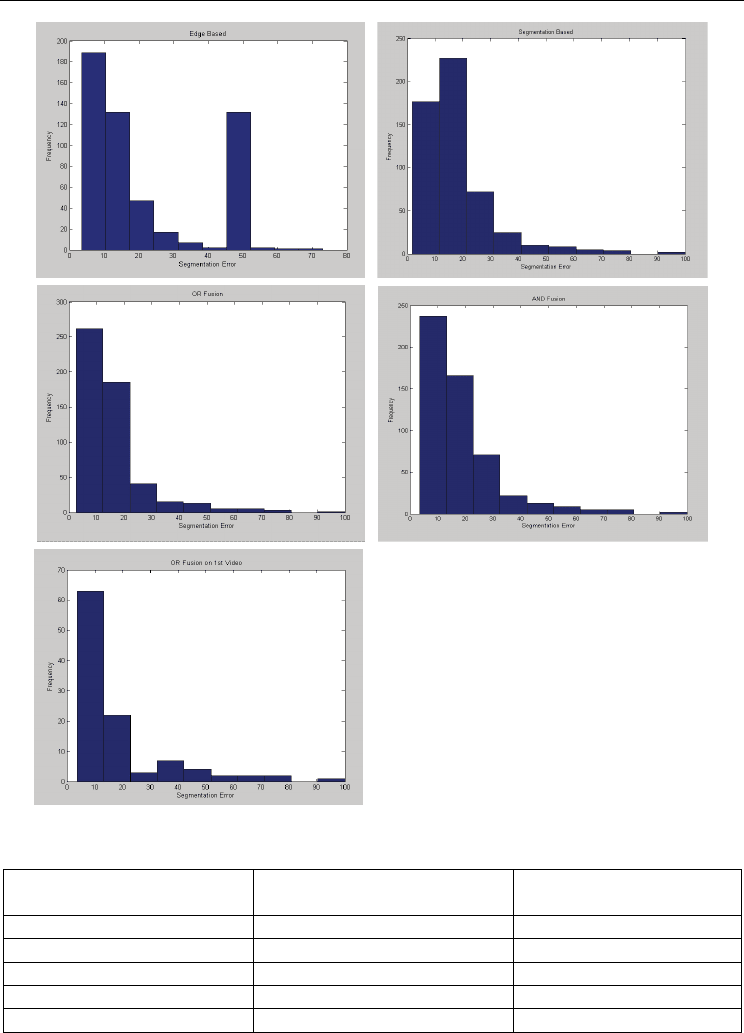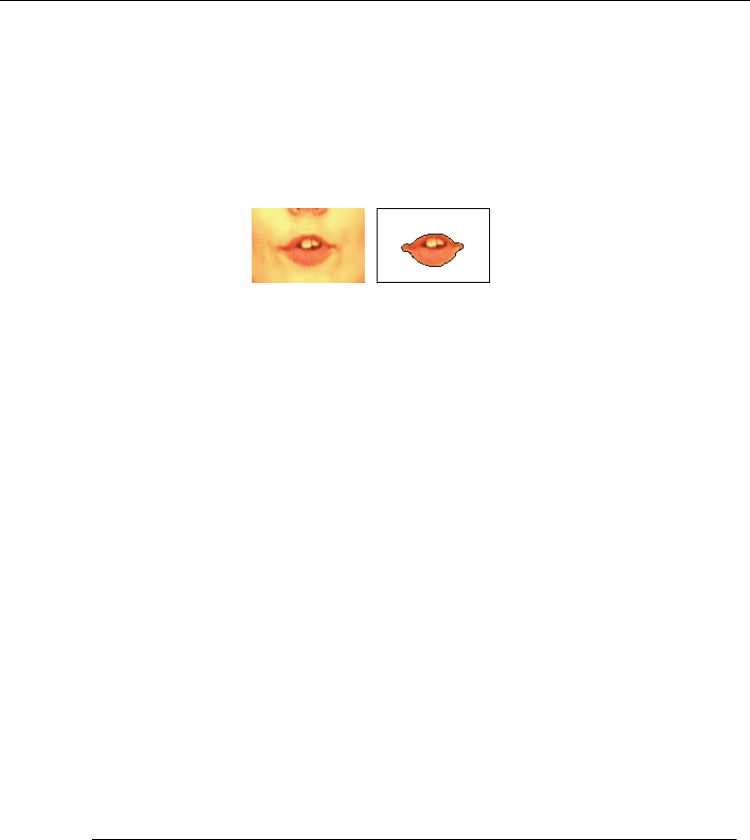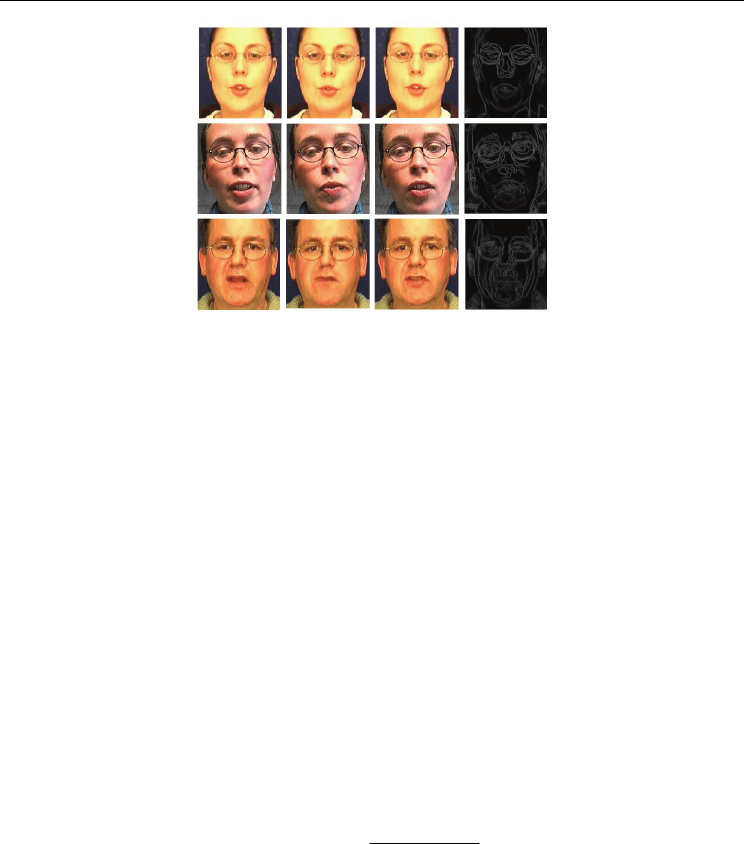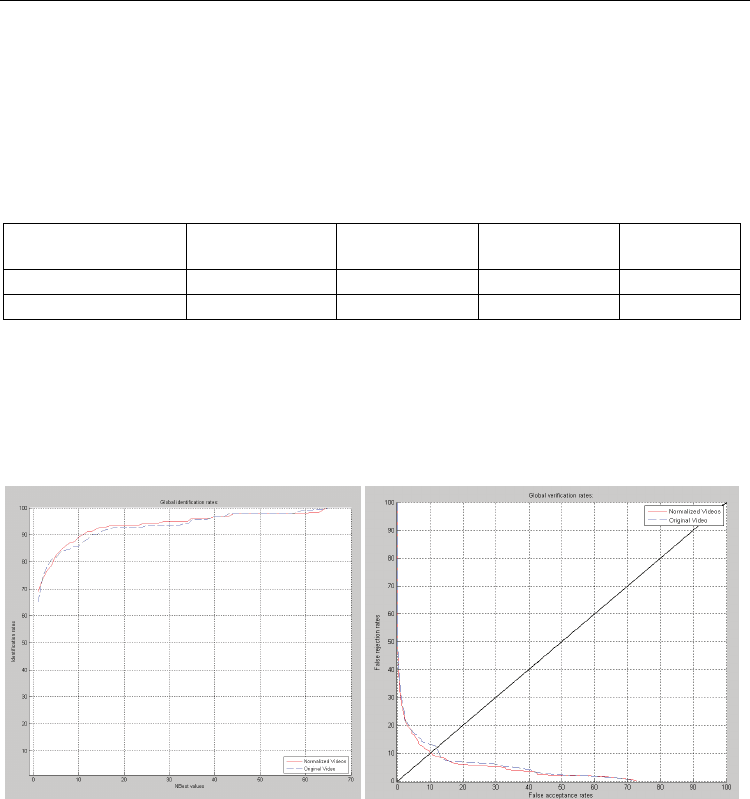Yang J., Nanni L. (eds.) State of the Art in Biometrics
Подождите немного. Документ загружается.


Temporal Synchronization and Normalization of Speech Videos for Face Recognition
149
Fig. 4. Histograms for Segmentation Errors
Lip Detection Method Mean Segmentation Error
(SE) %
Mean Overlap (OL) %
Segmentation Based 17.8225 83.6419
Edge Based 22.3665 65.6430
OR Fusion 15.6524 83.9321
AND Fusion 18.4067 84.2452
OR Fusion on 1st Video 13.9964 87.1492
Table 2. Lip detection Results

State of the Art in Biometrics
150
Fig. 5. Example of Images with 15 % Segmentation Error
3. Synchronization
In this section we propose a temporal synchronization method that, given a group of videos
for a person repeating the same phrase in all videos, studies the lip motion in one of the
videos and selects synchronization frames based on a criterion of significance (optical flow).
The next module then compares the motion of these synchronization frames with the rest of
the videos and selects frames with similar motion as synchronization frames. For evaluation
of our proposed method we use the classical eigenface algorithm to compare
synchronization frames extracted from the videos and random frames to observe the
improvement in a face recognition results.
The proposed synchronization method can be divided into two main parts; first is a
selection method which selects frames in one of the video that are considered significant,
second is a search algorithm in which the synchronization frames selected in the first video
are synchronized with the remaining videos.
3.1 Synchronization frame selection
The aim of this module is to select synchronization frames from the first video of the group
of videos for a specific person. Given a group of videos V
i
for the person p, where i is the
video index in the group, this module takes the first video V
1
for each person as input and
selects synchronization frames SF
1
, that are considered useful for synchronization with the
rest of the videos. The criterion for significance is based on amount of lip motion, hence
frames that exhibit more lip motion as compared to the frames around them are considered
significant. First for the video V
1
the mouth region of interest (ROI) MI
t
for each frame t is
isolated based on tracking points provided with the database. Then frame by frame optical
flow is calculated using the Lucas Kanake method (cf. Figure 6) for the entire video resulting
in a matrix of horizontal and vertical motion vectors. As we are interested in a general
description of the amount of lip motion in the frame we then calculate the mean of the
motion vectors Of
t
(cf. Figure 8) for each mouth ROI MI
t
.
,, ,, 1
,, ,,
11
11
[](,)
(( ) ( ))
mnt mnt t t
MN
tmntmnt
mn
for t to N
uv LKMIMI
Of abs u abs v
end
+
==
←
−
=
=+
∑∑
Fig. 6. Mean optical flow algorithim
Where T is the number of frames in the video V
i
, LK() calculates the Lucas Kanade optical
flow. u
m,n,t
and v
m,n,t
are the horizontal and vertical components of the motion vectors at row
m and column n of the frame t.

Temporal Synchronization and Normalization of Speech Videos for Face Recognition
151
(a) (b) (c)
Fig. 7. (a) Mouth ROI. (b) LK optical flow. (c) Mean vector.
Fig. 8. Mean optical flow Of
t
for video
The next step is to select synchronization frames SF
1
based on the mean optical flow Of
t
, if
we select frames that exhibit maximum lip motion there is a possibility that these frames
might lie in close vicinity to each other. Thus we decided to divide the video into
predefined segments (cf. Figure 8) and then select the frame with local maxima as
synchronization frames.
1
1( )
(max( ))
ttD
for t to N D with incriments of D
SF Frame with value Of to Of
end
N
where D
K
+
←−
=
=
Fig. 9. Syncronization frame selecion algorithim
Where T is the total number of frames in the video. K is the number of synchronization
frames, its value is predefined and is based on the average temporal length of the videos in
the database and will be given in the experiments and results section.
3.2 Synchronization frame matching
In the previous module we have selected synchronization frames from the first video of a
person and in this module we try to match these frames with the remaining videos in the
group. This module can be broken down into several sub-modules, the first one is a feature
extractor where we extracted two features related to lip motion. The second is an alignment
algorithm that aligns the extracted lip features before matching, and the last sub-module is a
search algorithm that matches the lip features using an adapted mean-square error
algorithm. This results in the synchronization frame matrix SF
i
for each person.

State of the Art in Biometrics
152
3.2.1 Feature extraction
In this section we have studied the utility of two mouth features, the first one is quite simply
the mouth ROI (MI
t
) as used in the previous module, the second is based on lip shape and
appearance (LSA
t
) and its is based on the outer lip contour extracted in Section 1. Once the
outer lip contour is detected the background is then removed and the final feature is
obtained as depicted in Figure 9. It contains the shape information in the form of lip contour
and the appearance as pixel values inside the outer lip contour. Thus the feature image J
may consist of either MI
t
or LSA
t
.
Fig. 10. Lip Feature Image
3.2.2 Alignment
Before the actual matching step, it is imperative that the feature images J (MI
t
, LSA
t
) are
properly aligned, the reason being that some feature images maybe naturally aligned and
thus have unfair advantage in matching. The alignment process is based on minimization of
mean square error between feature images.
3.2.3 Synchronization frame matching
The last module consists of a search algorithm, which tries to find frames having similar lip
motion as synchronization frames selected from the first video in the rest of the videos. The
algorithm is based on minimizing the mean square error, adapted for sequences of images.
Let J
f(k),i,w
be the feature image, where k is the synchronization frame index, f(k) is the
location of the synchronization frame in the video, i describes the video number and w the
search window, which is fixed to +/-5 frames. Thus the search algorithm tries to find
synchronization frames SF
i
by matching the current feature image J
f(k),1,0
previous feature
image J
f(k)-1,1,0
and the future feature image J
f(k)+1,1,0
from the first video with the rest of the
videos within a search window w. The search window w is created in the rest of the video
centred at the location of the synchronization frame from the first video given by f(k).
22 22 22
()1,1,0 ()1,, (),1,0 (),, ()1,1,0 ()1,,
1
2
() 5 () 5
(( )( )) (( )( )) (( )( ))
argmin
(*)
fk fk iw fk fkiw fk fk iw
i
J
for k to No of Synchronization Frames
for i to No of Videos Per Person
forw fk tofk
JJ JJ JJ
SF
MN
−− ++
←
←
←− +
−+ −+ −
=
∑∑ ∑∑ ∑∑
Fig. 11. Syncronization frame matching algorithim
Where SFi is the final matrix that contains the synchronization frames for all the videos Vi
for one person.
3.3 Person recognition
Classification was carried out using the eigenface technique (Turk & Pentland, 1991). The
pre-processing step consists of histogram equalisation and image vectorisation (image pixels
are arranged in long vectors).

Temporal Synchronization and Normalization of Speech Videos for Face Recognition
153
We apply a linear transformation from the high dimensional image space, to a lower
dimensional space (called the face space). More precisely, each vectorised image
n
s is
approximated with its projection in the face space
D
n
∈
ℜv by the following linear
transformation, equation 5.
vW(s )
T
nn
=
−μ (5)
where
W
is a projection matrix with orthonormal columns, and
D
∈
ℜμ is the mean image
vector of the whole training set, equation 6.
,
11
1
J
N
j
n
jn
JN
==
=
∑∑
μ s (6)
in which J is the total number of sequences in the training set, and
,jn
s is the n -th
vectorised image belonging to video
j
Φ
. The optimal projection matrix W is computed
using the principal component analysis (PCA).
After the image data set is projected into the face space, the classification is carried out using
a nearest neighbour classifier which compares unknown feature vectors with client models
in feature space. The similarity measure adopted
S, equation 7, is inversely proportional to
the cosine distance.
(,)1
|| |||| ||
T
ij
ij
ij
yy
Sy y
yy
=− (7)
and has the property to be bounded into the interval [0, 1].
3.4 Experiments and results
Tests were carried out on Valid Database (Fox et al., 2005) which consists of five recording
sessions of 106 subjects using the third utterance. The videos contain head and shoulder
region of the subjects and the subjects are present in front of the camera from the beginning
till the end.
The first video
V
1
was selected for the synchronization frame selection module and the rest
of the 4 videos were then matched with the first video using the synchronization frame
matching module. To estimate the improvement due to our synchronization process we
have compared the synchronization frames
SF
i
and randomly selected frames using the
person recognition module. The first video was excluded from training and testing due to its
unrealistic recording conditions, 2nd and 3rd videos were used for training and 4th and 5th
were used for testing both synchronization and random frames.
We apply PCA to the enrolment subset to compute a reduced face space of 243 dimensions.
Then, the client models are registered into the system using their centroid vectors, which are
calculated by taking the average of the feature vectors in the enrolment subset; in the end,
recognition is achieved using a nearest neighbour classifier with cosine distances.
We have created 8 datasets from our database by varying the parameters such as selection
method, the type of feature image and the number of synchronization frames. The results
are summarized in Table 3, the first column gives dataset number, the second column the
method for selecting frames, the first 4 datasets use the proposed synchronization frame
selection method and the last 4 datasets were created by selecting random frames from the

State of the Art in Biometrics
154
videos. The third column signifies which lip features were used in the synchronization
frame matching module. The fourth column is the number of synchronization frames
K that
were used for each video, in this study we have limited K to only 7 and 10 frames as most of
the video in our database ranged from 60 to 110 frames. In case of last 4 datasets the
number of synchronization frames simply signifies the number of random frames selected.
The last column gives the identification rates.
Dataset Method Lip
Feature
Number of
Synchronization Frames
Identification
Rates
1 Synchronization MI 7 71.80 %
2 Synchronization MI 10 74.18 %
3 Synchronization LSA 7 72.28 %
4 Synchronization LSA 10 74.02 %
5 Random - 7 69.01 %
6 Random - 10 69.92 %
7 Random - 7 69.64 %
8 Random - 10 68.85 %
Table 3. Person Recognition Results
The main result of this study is the overall improvement of identification results from
synchronization frames as compared to random frames, which is evident from the Table 3. If
we compare the identification results from the first 4 and last 4 datasets, it is obvious that
there is an average improvement of around 4% between the 2 group of datasets. The second
result that can be deduced is the improvement of recognition rates when more
synchronization frames are used. The number of synchronization frames in the case of
random frames simply signifies how many random frames were used and as it can be seen
from the Table 3, using more random frames has no impact on the identification results. The
third is insignificant change with regards to using
MI or LSA as features. Here we would
like to emphasize that the amount of testing for the second and third results is rather limited
but this was not the main focus of this study.
4. Normalization
This section of the chapter consists of a temporal normalization algorithm that takes the
synchronization frames from the previous module and normalizes the length of the video by
lip morphing. Firstly the videos are divided into segments defined by the location of the
synchronization frames. Next the normalization is carried out independently for each
segment of the video by first selecting an optimal number of frames for each segment and
then adding and removing frames to normalize the length of the video. The evaluation is
carried out by comparing normalized videos with the original videos in a person
recognition scenario.
4.1 Optimal number of frames
Given the video
V
i
, it is first divided into segments S
q
, where q is the number of segments
and is equal to the number of synchronization frames plus one. Next the optimal number of
frames
O
q
for each corresponding segment S
q
is calculated by averaging the number of
frames F
i,q
in the corresponding segment of the videos V
i
.

Temporal Synchronization and Normalization of Speech Videos for Face Recognition
155
,
1
1
1
I
i
q
i
q
for q to Q
for i to I
F
O
I
=
←
←
=
∑
Fig. 12. Optimal number algorithim
4.2 Transcoding
The next step is to add/remove frames (commonly known as transcoding) from each segment
of the video so as to make them equal to the optimal number of frames. The simplest
techniques for transcoding like up/down-sampling and interpolation results in jerky and
blurred videos respectively. Advanced technique such as motion compensated frame rate
conversion (Ugiyama et al., 2005), use block matching to estimate and compensate for motion
but are imperfect as they lack information about the type of motion and thus frequently
consider a uniform linear model of motion. As for this study we already have an estimation of
lip motion from previous modules, we decided to use image morphing instead of block
matching/compensation which results in visually superior results.
Morphing is the process of creating intermediate or missing frames from existing frames.
Mesh morphing (Wolberg, 1996), one of the well studied techniques consists of creating a
morphed frame
I
m
from source frame I
s
and target frame I
t
by selecting corresponding
feature points in I
s
and I
t
, creating a mesh based on these feature points, warping I
s
and I
t
and finally interpolating warped frames to obtain the morphed frame I
m
. In our study
morphing was carried out only on the lip ROI as this region exhibits the most significant
motion in the video. Lip ROI was first isolated and outer lip contour detected as in the
previous section. These Lip ROI formed the I
s
and I
t
frames, feature points consisted of the 4
extremas of the outer lip contour (top, bottom, left, right). Mesh morphing was then carried
out. Finally the morphed Lip ROI was superimposed on the original image to obtain the
morphed frame (cf. Figure 13).
Fig. 13. (a) Existing Frames (b) Lip ROI (c) Morphed Lip ROI (d) Morphed Frame

State of the Art in Biometrics
156
Decision regarding the number of frames to be added/removed is taken by comparing the
number of frames in each segment S
q
to the optimal number of frames; the frames are then
added/removed at regularly spaced intervals of the segment. Addition of a frame consists
of creating a morphed frame
I
i
from previously existing frames, I
i-1
and I
i+1
. Similarly frame I
i
is removed by morphing frames I
i-1
and I
i
and replacing I
i-1
with the morphed frame, and
replacing frame I
i+1
with the morphed frame from I
i
and I
i+1
. Finally deleting the frame I
i
.
Thus
11
11
11
(,)
Re
(,)
(,)
()
iii
iii
iii
i
Frame Addition
IMorphII
Frame moval
IMorphII
IMorphII
Delete I
−
+
−−
++
←
←
←
Fig. 14. Frame addition/deletion algorithim
4.3 Person recognition
For testing our normalization algorithm we used a spatio-temporal method proposed by
(Matta & Dugelay, 2008). It consists of two modules: Feature Extraction, which transforms
input videos into “X-ray images” and extracts low dimensional feature vectors, and Person
Recognition, which generates user models for the client database (enrolment phase) and
matches unknown feature vectors with stored models (recognition phase).
4.3.1 Feature extraction
Inspired by the application of discrete video tomography (Akutsu & Tonomura, 1994) for
camera motion estimation, we compute the temporal X-ray transformation of a video
sequence, to summarize the facial motion information of a person into a single X-ray image.
It is important to notice that we restrict our framework to a fixed camera; hence, the video
X-ray images represent the motion of the facial features and some appearance information,
which is the information that we use to discriminate identities.
Given an input video of length
T
i
, V
i
≡ {I
i
,1, . . . , I
i
,T
i
}, the Feature Extractor module first
calculates the edge image sequence
E
i
, obtained by applying the Canny edge-finding
method (Canny, 1986) frame by frame, equation 8.
,1 , ,
{ , ...., } ( )
iiTiEFi
EJ J
f
V
≡
= (8)
Then, the resulting binary frames,
J
i,t
, are temporally added up to generate the X-ray image
of the sequence, equation 9.
,
1
i
T
iit
t
XC J
=
=
∑
(9)
where C is a scaling factor to adjust the upper range value of the X-ray image.

Temporal Synchronization and Normalization of Speech Videos for Face Recognition
157
Fig. 15. Original Frames and Temporal X-ray Image.
After that, the Feature Extractor reduces the X-ray image space to a low dimensional feature
space, by applying the principal component analysis (PCA) (also called the Karhunen-Loeve
transform (KLT)): PCA computes a set of orthonormal vectors, which optimally represent
the distribution of the training data in the root mean squares sense. In the end, the optimal
projection matrix,
P, is obtained by retaining the eigenvectors corresponding to the M
largest eigenvalues, and the X-ray image is approximated by its feature vector,
M
i
y ∈ℜ calculated using the linear projectionin equation 10.
()
T
ii
yPx
μ
=
− (10)
where
x
i
is the X-ray image in a vectorial form and μ is the mean value.
4.3.2 Person recognition
During the enrolment phase, the Person Recognition module generates the client models
and stores them into the system. These representative models of the users are the cluster
centres in feature space that are obtained using the enrolment data set.
For the recognition phase, the system implements a nearest neighbour classifier which
compares unknown feature vectors with client models in feature space. The similarity
measure adopted S, equation 11, is inversely proportional to the cosine distance.
(,)1
|| |||| ||
T
ij
ij
ij
yy
Sy y
yy
=− (11)
and has the property to be bounded into the interval [0, 1].
4.4 Experiments and results
Tests were carried out on Valid Database (Fox et al., 2005) which consists of five recording
sessions of 106 subjects using the third utterance. The first video was selected for the
synchronization frame selection module and the rest of the 4 videos were then synchronized
with the first video using the synchronization frame matching module. Finally all videos
were temporally normalized.

State of the Art in Biometrics
158
To estimate the improvement due to our normalization process we have compared the
normalized videos generated by our algorithm to original non-normalized videos using the
person recognition module described above. First 3 videos were used for training and the
rest 2 were used for testing. The number of synchronization frames in this study have been
set to 7, as the average number of frames per video in our database was approximately 70.
The recognition system has been tested using a feature space of size 190, constructed with
the enrolment data set. The video frames are also pre-processed using histogram
equalization, in order to reduce the illumination variations between different sequences.
Method
CIR %
(1st )
CIR %
(5th )
CIR %
(10th )
EER %
Normalized Video
69.02 % 82.60 % 89.13 % 10.1 %
Original Video
65.21 % 81.52 % 85.86 % 11.9 %
Table 4. Person Recognition Results
The identification and verification results are summarized in Table 4; its columns report the
correct identification rates (CIR), computed using the best, 5-best and 10-best matches, and
the equal error rates (EER) for the verification mode. We notice that the recognition system
using normalized videos performs better than the analogous one working with non-
normalized videos. Detailed Identification and EER Rates are given in figure 16.
Fig. 16. Correct Identification Rates (CIR) and Verification Rates (EER)
5. Conclusions
In this chapter at first, we have presented a novel lip detection method based on the fusion
of edge based and segmentation based methods, along with empirical results on a dataset of
considerable size with illumination and speech variation. We observed that the edge based
technique is comparatively more accurate, but is not so robust and fails if lighting conditions
are not favourable, thus it ends up selecting some other facial feature. On the other hand the
segmentation based method is robust to lighting but is not as accurate as the edge based
method. Thus by fusing the results from the two techniques we achieve comparatively
better results which can be achieved by using only one method. The proposed methods
